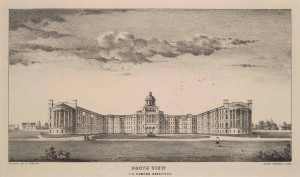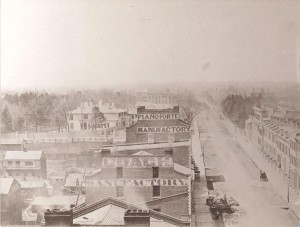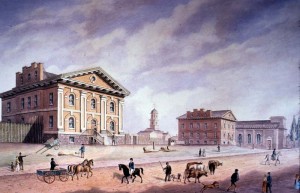Chapter 10. Societies of British North America to 1860
10.5 City Life

At the start of the post-Napoleonic era cities in British North America were mostly large towns. They were small in population and area, they served very local markets, and their people consisted mainly of merchants, artisans, physicians and lawyers, government and military officials, clergy, and not much more. Until the 1840s, Halifax, for example, was essentially a city built of wood; in the generation that followed, its centre would be largely rebuilt in stone and brick. By the 1860s, the most dynamic cities had grown significantly and were much more complex places.
The Modern City
Civic buildings became common and were a source of pride for the citizens. There was confidence and ambition in a young city that invested in stone buildings; the resident merchants and professionals located their mansions near the centre of town where they could be pointed to as evidence of community wealth; infrastructure like waterworks, board sidewalks, and a firehall were indicators of a commitment to the future and an enterprising attitude. The optimism of the age — the belief that a community’s citizens were building a glorious society with a long life expectancy — was embodied in the move to neoclassical design in these new public and civic spaces that suggested (not very modestly) a common and timeless connection with ancient Greece and Rome.
Few of these small cities had rows of shops just yet — they typically had public markets where grocers, butchers, fishmongers, and bakers hawked their wares. There was space as well for farmers from the nearby countryside to sell cash crops to the growing town population.
Michael Katz studied the people and patterns of life in mid-century Hamilton and he closely observed the transition that was underway there (and in many other cities):
[B]y 1861 some men could see that the future lay not only in trade but even more in manufacturing. By that time advocates of industry had begun a campaign to persuade the entrepreneurs of the city that the future lay in the factory as much, or more than, in the countinghouse. At first their successes remained modest. In 1861 the Wanzers moved their sewing-machine factory to Hamilton from Buffalo; someone partially manufactured shoes which were finished by hand; there were a prosperous factory that made pianos, one that manufactured hats, and, of course, the yards of the Great Western Railway and the construction of locomotives. Overall, in 1861 Hamilton remained a commercial city, though the future already was clear to anyone who read the signs. The ambitious little city would become the Birmingham [England] of Canada.[1]
By mid-century some cities were ready to leave behind Katz’s “commercial city.” For less than a century they had developed as nodes of commerce and local trade, sometimes tentatively reaching out into a larger global economy but (with the exception of Montreal and perhaps Quebec and Saint John), as commercial towns they had reached their upward limits: Toronto held about 40,000 and Hamilton a little more than 10,000; Halifax was creeping up above 20,000 and Charlottetown 7,000. Montreal was the giant with a population around 90,000 and was thus an example of where the future might lie.
Industrialization in these days, however, meant consolidation of some producers, heavy secondary manufacturing like an iron foundry, and other similar operations that might hire a few dozen employees at best. Full-on industrialization would come later in the century and, with it, massive growth in city size and a complete overhaul in what it meant in practical terms to be a citizen.
It is worth noting, however, that from 1851 to 1861 about 13% of British North Americans lived in cities of 20,000 or more, which put the emergent confederacy above the world average of 5%. The proportions in New Brunswick and the Province of Canada were highest, at around 14% living in cities in 1851, with Canada West accelerating to 18.5% in 1861. These numbers show that more British North Americans were moving to a handful of large centres and, simultaneously, more centres were passing the 20,000 threshold to qualify as cities. Some people, in other words, “urbanized” by sitting still. [2]

Historians on Video
Urban spaces created a public domain in which people gathered to celebrate, protest, and mourn, among other things. Royal visits are an example of this, something that would have been largely unthinkable in an entirely rural environment of farmland, hamlets, and villages. Historian Ian Radforth (University of Toronto) considers such events in the first video below and then, in the second video, addresses the far more regular phenomenon of public displays and spectacles. The transcripts, respectively, may be found here: transcript for introductory video and video on royal visit of 1860 [PDF] and transcript for video on street spectacles [PDF].
Sin City
The emergence and growth of cities brought to light many social problems — crime, poverty, and alcoholism being the most obvious. There were, as well, so-called moral issues like unwed motherhood, gambling, and prostitution (the last of these was not always regarded as a criminal activity in the 19th century). The response was the creation of institutions such as prisons, insane asylums, orphanages, and shelters for the poor. The protection of property (manifest in police stations, courts, and jails) and care for the weakest members of society (in asylums and hospitals) was part of a continuum of middle-class values that patrolled deviance and enforced the emerging standards. The wide support for these values was evident by the sometimes-competitive frenzy of funding and building the institutions that would mark a city as a “go-ahead” place. In the 1850s alone Halifax added to its list of government buildings the Lunatic Asylum, the City Hospital, Rockhead Prison, the Halifax Court House, and the County Jail.[3]

The mid-19th century witnessed the emergence of philanthropy as a social phenomenon in British North America. To be wealthy was one thing; to be a philanthropist was something else altogether. Philanthropy had deeper roots in England where money had accumulated in the cities a century or two earlier. It was informed by Protestant values that placed a premium on doing good deeds as a means of achieving personal spiritual growth. And where one or two philanthropists could not make a project come together, an organization might. The Ladies Benevolent Society and the Hamilton Orphan Society, for example, addressed a constellation of concerns and were backed by middle-class Protestant women in Hamilton, Canada West. Their projects included a home for elderly women and an orphanage as well as a social work visitors initiative.[4]
In Montreal and Quebec, most of these institutions were Catholic, but there were Protestant operations as well. As Montreal grew, so did the Catholic institutional presence; the Protestants had to play catch-up. Civic leaders faced issues like poverty with mixed feelings: charity and care were needed but leading Protestants were fearful that their efforts would lead to more poverty and less individual effort on the part of vulnerable populations. But also, “the Montreal Protestant community was torn between the need to create its own relief network to alleviate destitution, in order to avoid forcing Protestants to compromise their souls by using the Roman Catholic system, and the prevalent ideology against making relief too easily available or too abundant.”[5] The result was a House of Industry in the 1860s that distinguished between the “deserving poor” (such as the elderly) and the able-bodied poor who could work for their keep. The division in Canada East between Catholic social work institutions and privately funded Protestant institutions kept the state out of the system for the most part (unlike in Canada West and the rest of English-speaking British North America), a fact that would come to have some bearing on the shape of Canadian federalism in the years to come.
Historians on Video
The development of institutions is a manifestation of what historian Ian Radforth (University of Toronto) refers to as “state formation.” Here is a link to the transcript for video on state formation [PDF].
Key Points
- British North American cities were taking on the trappings of bourgeois towns the world over, including investment in substantial civic buildings.
- Manufacturing — and the desire to have more factories — was a feature of the emerging early Victorian city.
- British North American society was, overall, more urban than most countries, even though it was very rural.
- Social problems and how to address them were the focus of attention from many urban leaders.
Video Attributions
- Dr. Ian Radforth Question 1 – Introduction © 2015 by TRU Open Learning is licensed under a CC BY (Attribution) license
- Dr. Ian Radforth Question 6 – 1860 British royal visit to Canada. © 2015 by TRU Open Learning is licensed under a CC BY (Attribution) license
- Dr. Ian Radforth Question 7 – Street spectacles and displays of public opinion. © 2015 by TRU Open Learning is licensed under a CC BY (Attribution) license
- Dr. Ian Radforth Question 2 – State formation in British North America. © 2015 by TRU Open Learning is licensed under a CC BY (Attribution) license
Media Attributions
Figure 10.5
Provincial Asylum Toronto by Skeezix1000 is in the public domain.
Figure 10.6
Toronto from the top of the Rossin House Hotel by Skeezix1000 is in the public domain.
Figure 10.7
North side of King Street East, from Toronto to Church Streets by Skeezix1000 is in the public domain.
- Michael B. Katz, The People of Hamilton, Canada West: Family and Class in a Mid-Nineteenth-Century City (Cambridge, Mass.: Harvard University Press, 1975), 4-6. ↵
- Leroy O. Stone, "Urban Development in Canada," in Perspectives on Canada's Population: An Introduction to Concepts and Issues, eds. Frank Trovato and Carl F. Grindstaff (Don Mills: Oxford University Press, 1994), 372. ↵
- Susan Buggey, "Building Halifax, 1841-1871," Acadiensis X, no. 1 (Autumn 1980): 90. ↵
- Carmen J. Nielson, Private Women and the Public Good: Charity and State Formation in Hamilton, Ontario, 1846-93 (Vancouver: UBC Press, 2014). ↵
- Janice Harvey, "Dealing with 'the destitute and the wretched': The Protestant House of Industry and Refuge in Nineteenth-Century Montreal," Journal of the CHA 2001 Revue de la SHC,12 (2001): 74-5. ↵

